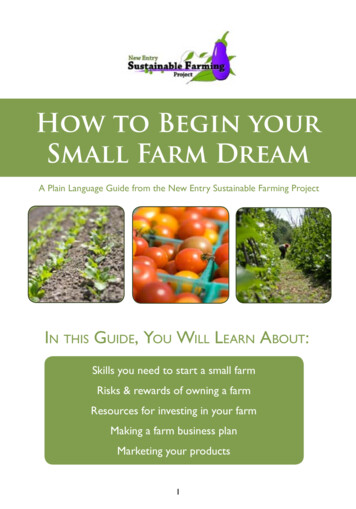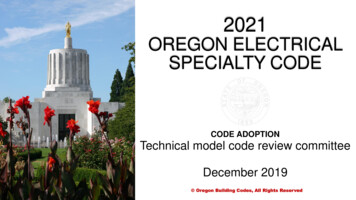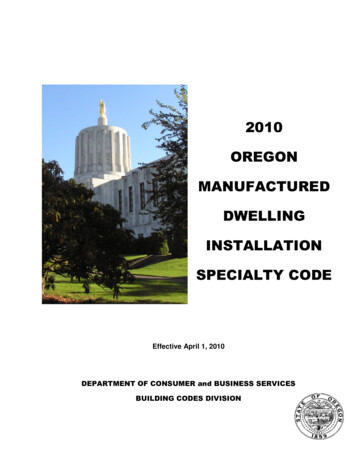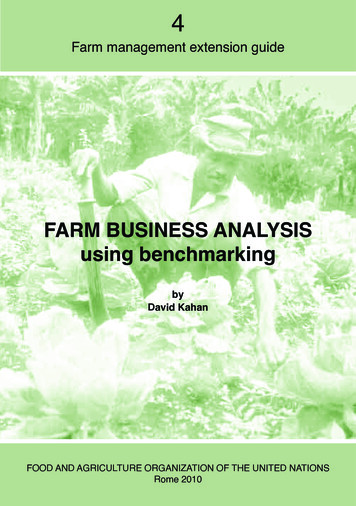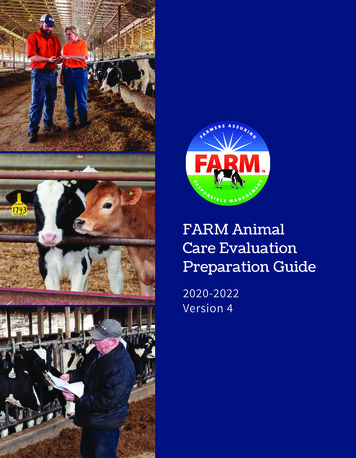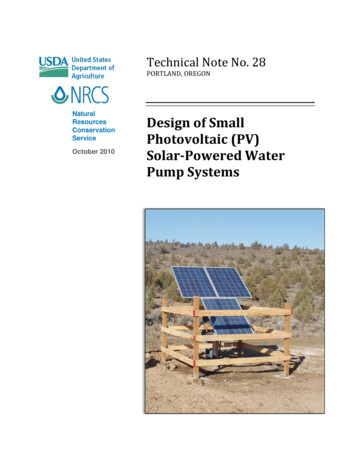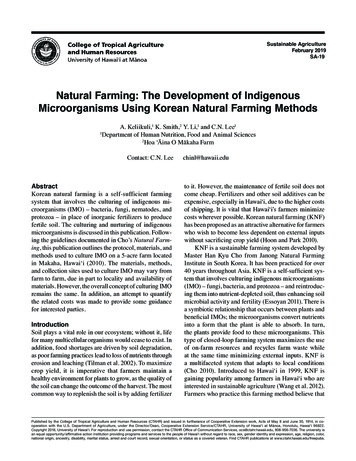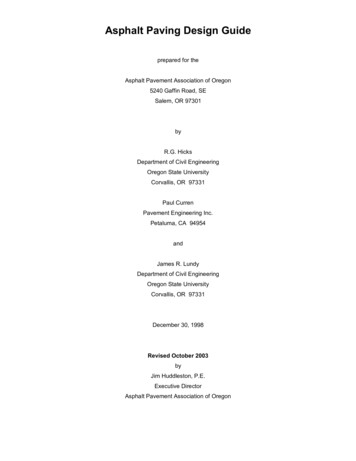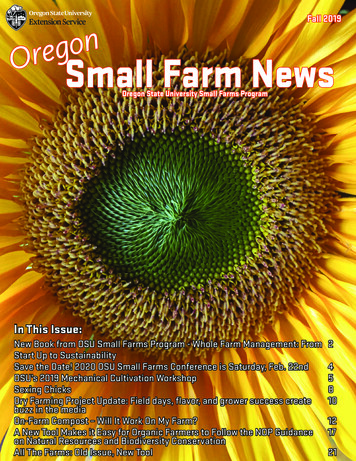
Transcription
Fall 2019nogerOSmall Farm NewsOregon State University Small Farms ProgramIn This Issue:New Book from OSU Small Farms Program - Whole Farm Management: From 2Start Up to SustainabilitySave the Date! 2020 OSU Small Farms Conference is Saturday, Feb. 22nd4OSU’s 2019 Mechanical Cultivation Workshop 5Sexing Chicks 8Dry Farming Project Update: Field days, flavor, and grower success create10buzz in the mediaOn-Farm Compost – Will It Work On My Farm?12A New Tool Makes it Easy for Organic Farmers to Follow the NOP Guidance17on Natural Resources and Biodiversity ConservationAll The Farms: Old Issue, New Tool 21
OSU Extension Service SmallFarms ProgramGarry StephensonExtension Small Farms SpecialistCorvallis, OR 97331Lauren GwinExtension Community Food Systems SpecialistCorvallis, OR 97331Nick AndrewsClackamas & Washington Counties, 503-6781264Javier Fernandez-SalvadorMarion & Polk Counties, 503-588-5301Melissa FeryBenton, Linn, & Lane Counties, 541-766-6750Amy GarrettBenton, Linn, & Lane Counties, 541-766-6750Pamela MonnetteLincoln County, 541-283-5119Maud PowellJackson & Josephine Counties, 541-776-7371Sara RunkelJosephine County County, 541-476-6613Heather StovenYamhill County, 503-678-1264Clare SullivanCentral Oregon, 541-548-6088Victoria BinningOutreach Progam Coordinator, Marion & PolkCounties, 503-373-3774Chrissy LucasOutreach Progam Coordinator, Statewide,541-766-3556Heidi NoordijkProgram Assistant, Clackamas & WashingtonCounties, 503-678-1264Teagan MoranProgram Assistant,Benton, Linn & LaneCounties, 541-766-3553New Book from OSU SmallFarms Program - Whole FarmManagement: From Start Upto SustainabilityOperating a farm businessrequires managingdreams, crops, people, markets,money, and reality. Whole FarmManagement: From Start Up toSustainability provides guidancefor starting, nurturing, andmaintaining a farm business.Drawing on the experienceand insights of 12 contributingauthors and 16 farmers fromacross North America, the bookoffers a holistic approach tofarm management for smalland medium size farms that usesustainable and organic methods, and sell their products throughlocal and regional markets.Conceptually, whole farm management helps farmers identify themany connections and interactions within the farm and developan integrated approach to decision-making that considers all thecomponents of the farm business—environmental, economic, andsocial.The chapters lead beginning and experienced farmers through theinterconnecting parts of a whole farm with the goal of making gooddecisions based on knowledge of the effects each part of the farmhas on all parts of the farm: Dream It: Plan and manage goals for an ideal farmCover Photo:Rain Drop Farm sunflower. Philomath,OR. Do It: Develop a strategy for farm operations and resourcesCredit: Garry Stephenson, OSU SmallFarms Program Manage It: Implement successful business accounting practicesOregon Small Farm News Layout by: Chrissy LucasOregon State University Extension Service offers educationalprograms, activities, and materials without discrimination basedon race, color, religion, sex, sexual orientation, national origin,age, marital status, disability, and disabled veteran or Vietnam-eraveteran status. Oregon State University Extension Service is anEqual Opportunity Employer.Oregon Small Farm News Sell It: Create marketing plans for selling crops Grow It: Work with the natural cycles of the farm ecosystemto support long-term farm sustainably Keep It: Maintain success with practical farm family businessstrategiesVol. XIIII No. 4 Page 2
The 16 farmers featured as case studies in thebook represent 9 farms from across the UnitedStates, producing a variety of crops and livestock.Their experience covers a wide range of productionsystems, business models, and environments,and includes new start-up farms as well asmultigeneration farms. Each has a unique storyin terms of how he or she has developed the farmbusiness. Featured farms include: Blue Fox Farm, Applegate, Oregon Goodfoot Farm, Kings Valley, Oregon Good Work Farm, Lehigh Valley, Pennsylvania Kiyokawa Family Orchards, Hood River Valley,Oregon Rainshadow Organics, Terrebonne, Oregon Slow Hand Farm, Portland, Oregon Sweet Home Farms, Sweet Home, Oregon Urban Buds: City Grown Flowers, St. Louis,Missouri Vanguard Ranch, Gordonsville, VirginiaThe 12 contributing authors work in educationalcapacities in farm production, food systemdevelopment, family and farm business management,and as farmers. They are associated with the Centerfor Small Farms & Community Food Systems, andAustin Family Business Program at Oregon StateUniversity, Oregon Tilth, Inc., and small organicfarms.Available through:“This book empowers anyone to start planting seedsfor a future farm business.”— Lisa Kivirist, author of Soil Sisters andHomemade for SaleIndie Bound—Community of Independent 60740“Whole Farm Management is an indispensableresource. It has just as much value for the beginningfarmer learning how to produce a crop at profit as itdoes for the journeyperson who is already in business,looking to avoid burnout.”— Andrew Mefferd, farmer, author, andeditor of Growing for MarketOregon Small Farm NewsPowell’s City of arnes & nagement-garry-stephenson/1130405412;jsessionid 6EDF62EFD43E7A5019CA06A99219B9D0.prodny store01-atgap11?ean 41/ref tmmpap swatch 0? encoding UTF8&qid &sr Vol. XIIII No. 4 Page 3
Save the Date! 2020 OSU Small Farms Conference isSaturday, February 22ndAnother great Oregon State University SmallFarms Conference is on the horizon.Save Saturday February 22nd 2020Featured Speaker:Andrew Mefferd editor of Growing for Marketmagazine, and author of The Greenhouse andHoophouse Grower’s Handbook and The Organic NoTill Farming Revolution.Andrew spent seven years in the researchdepartment at Johnny’s Selected Seeds, travelinginternationally consulting with researchers andfarmers on the best practices in greenhousegrowing. He puts what he learned to use on his ownfarm in Maine. Previously he worked on farms inPennsylvania, California, Washington State, Virginia,New York State and Maine before starting his ownfarm. For more about the magazine, please visitwww.growingformarket.com. To contact Andrew, seewww.andrewmefferd.com.As always, the OSU Small Farms Conference willfeature: Educational sessions on farming and the foodsystem Exhibits by over 50 organizations The best locally sourced lunch you can get inFebruary Networking and local beer and wine tastingduring Think with a DrinkStay tuned for more speakers.Registration will open in late December eAndrew Mefferd. Photo provided by Andrew MefferdNew Publication from OSU!Basics of Fall Cover Croppingfor Hemp in OregonHemp may only be grown in compliance with applicable state andfederal law, including the 2014 and 2018 farm bills and anticipated U.S.Department of Agriculture regulations. The following information isfor educational purposes only to inform licensed growers operating incompliance with applicable state and federal laws. Consult your localauthorities, Department of Agriculture representatives, or personal attorneyfor questions regarding the legality of growing hemp in your jurisdiction.Written by: Gordon Jones, Valtcho D. Jeliazkov, Richard J. Roseberg, SamD. AngimaAvailable online at tmlOregon Small Farm NewsVol. XIIII No. 4 Page 4
OSU’s 2019 Mechanical Cultivation WorkshopBy: Clare Sullivan & Heidi Noordijk, Oregon State University Small Farms ProgramOn August 29th, 2019the second OSUMechanical CultivationField Day was held at theNorth Willamette Researchand Extension Centerin Aurora. The day-longevent was attended byover 100 people, manyof the participants werefarmers. The goal of theevent was to increase theholistic weed managementknowledge base ofvegetable farmers, andprovide a platform forfarmer and equipmentsupplier exchange of ideasand opportunities. Valuablefeedback gained from 2018 field day evaluationsadded new elements to the 2019 field day, includinga focus on walk-behind cultivation equipment,non-mechanical methods of weed control, and anexperienced farmer discussion panel.Walk-Behind Cultivation ToolsThe morning demonstrations showcased walk-behindequipment in radish, cabbage, and radicchio plots.Equipment dealers traveled from near and far for theOregon Small Farm NewsAll photos provided by Clare Sullivan and Heidi Noordijkevent. Equipment included electric hoes from Carts &Tools (Oregon), various non-powered hand tools fromJohnny’s Selected Seed (Maine), the Ox a walk-behindcultivating tractor from Tilmor (Ohio), and the walkbehind tractor for bed shaping from BCS (Oregon).Tractor Mounted Cultivation ToolsThe afternoon demonstrated tractor-mountedcultivation tools, and equipment dealers traveled fromVol. XIIII No. 4 Page 5
Ohio (Tilmor), Pennsylvania (KULT-Kress) and California(Sutton Ag) to demonstrate tools in radish, radicchio,and cabbage crops. The cultivation equipment includedfinger weeders, knives and sweeps; toolbars were setupon both belly-mounted and rear-mounted tractors.Participants were able to try the new Tilmor cultivatingtractor, and test out hand-steering rear-mounted toolbarsetups.Farmer PanelThe farmer panel held right after lunch was a highlightfor many field day attendees, and offered the chanceto hear from three experienced vegetable growers ofdifferent production scales. Josh Volk (Slow Hand Farm, 1 acre), Frank Battilega (Big B Farm, 50 acres), andJoe Siri (Siri and Son Farms, 500 acres) spoke of theirweed management successes and lessons learned, andanswered questions from the audience.Overwhelmingly, participants had a very positiveOregon Small Farm Newsexperience: 88% said the demonstrations were veryuseful or extremely useful; 96% said they gainednew information to improve weed management intheir crops; and 80% said they planned to use newcultivation equipment on their farm. Commentsincluded, “Tractor tool demos were very useful forme. Talking to the company reps was a quick way toget questions answered”, and “What was most usefulwas seeing the tools demonstrated, and having anopportunity to operate them.”In 2018 faculty within the Small Farms Programorganized the first OSU Mechanical Cultivation FieldDay, which was a huge success and attracted farmersfrom Oregon and Washington. In 2019 the OSU teamorganized a second field day, and this year were ableto collaborate with Washington State University(WSU) to host two field days in the PNW on the sameweek. This winter we will be launching a website withsome videos of cultivation tools in use, and otherVol. XIIII No. 4 Page 6
mechanical cultivation websites. The fielddays were made possible through a twoyear mini-grant from the USDA WesternSustainable Agriculture Research andEducation program (WSARE) to conducteducational outreach on mechanicalcultivation.The Small Farms team is interested incontinuing workshops and field dayson weed management. Please help usplan future workshops by filling outa short survey to let us know topicsand equipment you’d like to see atfuture field days. At https://forms.gle/KJndcyDjaTFN6VJB9Soil Testing for Productive Gardens, Pastures, & Farm FieldsLocation: Josephine County OSU Extension auditorium 215 Ringuette St., Grants PassDate: Thursday, Oct. 24th , 2019Time: 5:30 – 7:30 pmInstructors: Gordon Jones, Assistant Professor (of Practice) General Agriculture, Jackson and Josephine CountyExtension & Sara Runkel, Assistant Professor ( of Practice) Horticulture, Josephine County ExtensionCost: 15Register online here: http://bit.ly/jocosmallfarms or contact: OSU Extension Josephine County 541-476-6613Description: In this class, we will learn about the methods for collecting a soil sample, where to send soil for analysis,and most importantly, how to interpret the results and correct problems. We will use examples from both organic andconventional production systems. Before the class, follow the instructions in this guide (https://catalog.extension.oregonstate.edu/ec628) for collecting a soil sample and have it analyzed by one of the labs listed in this 8677). Bring in the soil test report from your garden, pasture, or fieldto review during class.Exploring the Small Farm DreamLocation: Josephine County Extension Service 215 Ringuette St. Grants Pass, OR 97527Date: Mon., Nov. 4, 11 and 18Time: 6:00 – 8:30 pmInstructors: Sara Runkel and Maud Powell, OSU Extension FacultySouthern Oregon abounds with enthusiastic farmers involved in pursuing the commercial small farm dream. The aimof this three-session course is to assist those considering a small-scale commercial farming operation learn what itwill take to start and manage a farm business and decide whether that is something they really want to pursue. . Itwill provide an excellent framework for new farmers to assess their skills and interests, learn the realities of farmbusiness ownership, and become connected to local resources. The OSU Extension Small Farms Department teaches,guides, and connects farmers to each other. In addition, we help find answers to all those questions that crop upalong the way.Register: online here: http://bit.ly/jocosmallfarms or contact 541-476-6613Oregon Small Farm NewsVol. XIIII No. 4 Page 7
Sexing ChicksBy: Dr. Toshihiko NishioTranslated and edited by: Shinji Kawai and Alice Formiga, Department of Horticulture, OregonState UniversityImprovements in agriculturaltechnology and breeding helpedstruggling Japanese farmingcommunities in the early 20thcentury. Since the 1990s, Dr.Toshihiko Nishio, a Japaneserice farming system researcher,published over 150 stories aboutthese innovations. By showing howthese discoveries derived fromcareful observation, patience, andin some cases, serendipity, wehope that farmers will realize howordinary people can contributeto the advancement of their localagricultural communities andbeyond.In the mid 1920s, a poultry farmerand his daughter visited the National HusbandryExperiment Station in the Chiba Prefecture of Japan.His name was Manabu Kojima, and he had come tolearn a new chick sexing technique. He introducedhimself to the staff, and told them that he hadbrought his daughter along because his hands weretoo stiff to pick up chicks.It was in the middle of a depression in the farmingcommunity, and the government was promotingincreased egg production as a means to save farms.Artificial incubation had recently been developed,and the number of chicks raised had increaseddramatically. Farmers needed a method that wouldallow them to determine the sex of their chicks asearly as possible, because they could not afford tofeed male chicks that could not be used for eggproduction. Until that time, chick sexing was doneby examining the coxcombs, or assessing featherdevelopment. It took a month before the sex could beidentified.Oregon Small Farm NewsChicksIllustration by Eiko Goto.The new chick sexing technique, called vent sexing,was developed by three researchers at the Chibaexperiment station in 1924: Kiyoshi Masui, ShigeoHashimoto and Isamu Ono. They found that malechicks have a slight bump on their “vent”, i.e. theopening below the tail, that does not appear onfemale chicks.After completing the training, Kojima tried it on hischicks. In practice, it was not so easy to detect thebumps, because here were many questionable bumpson the females. After examining 20,000 chicks,Kojima developed a guide that described the differentforms and colors of the bumps. His efforts inspiredresearchers like Masui to further refine the technique.The result was a standard that helped improve theaccuracy rate.In 1929, the first association for chick sexing wasstarted in the Aichi Prefecture. This led to thedevelopment of the National Association of ChickVol. XIIII No. 4 Page 8
Sexing, which still exists today. They improved thetechnique by hosting chick sexer competitions andnurturing highly qualified chick sexers.Early competition records show that it took 13minutes to examine 100 chicks, and the results werenot always perfect. Today, it can take a professionalchick sexer just over three minutes, with 100%accuracy. In 1933, Hikosaburo Yogi was sent to theU.S. to demonstrate the vent sexing technique atexperiment stations and universities. His accuracyrate was 100%, and his impressive results helped toestablish the technique in America.Recently, there have been attempts to mechanizechick sexing, to develop different color eggs usingbiotechnology to differentiate chick sexes, and to findways to examine eggs before they hatch. So whilevent sexing may eventually become obsolete, it willlikely still be used where these new techniques areunavailable or unaffordable. The invention of ventsexing teaches us that participation by people in thefield is key to developing and refining new technology,more so than merely introducing expensiveequipment.For many years, skilled Japanese chick sexerswere sent around the world to assist and trainchick farmers. The vent sexing technique is nowwidespread, and numerous countries have adoptedit. Although many countries now educate their ownexaminers, about a hundred Japanese examiners arestill sent overseas every year.Oregon Small Farm NewsVol. XIIII No. 4 Page 9
Dry Farming Project Update: Field days, flavor, andgrower success create buzz in the mediaBy: Amy Garrett, Lucas Nebert, and Teagan Moran, Oregon State University SmallFarms ProgramThis year marked the 5th annual series of dryfarming field days. Four field days were held thisyear in the mid to southern Willamette Valley, eachfeaturing multiple research projects engaging theDry Farming Collaborative (DFC). The DFC initiatedin 2016, now has more than 740 members in theFaceBook Group, 250 people connected via an emaillist who are interested in hosting trials, and 45 sites inthe maritime Pacific Northwest that have hosted trialssince 2016. More than 150 participants attendedDry Farming Field Days this year including: farmers,gardeners, researchers, journalists, and othersinterested in learning about strategies for growingfood with little to no irrigation in the WillametteValley. Field Days included blind tastings of dryfarmed vs. irrigated tomatoes and melons.Some of the research projects with the DFC featuredat the field days this year included: Variety Trials: 10 sites hosted potato, tomato,melon, and/or dry bean trials to assess howvarieties perform dry farmed in our bioregion (ledby A. Garrett, L. Nebert, and C. Homanics). Site Suitability Study: 20 sites participated inthe 2nd year of this study assessing what sitecharacteristics are suitable for dry farmingvegetable crops with support from Western SARE(led by A. Stone, A. Gallagher, and M. Davis). Fungal Inoculant Study: 13 sites participated inthe 2nd year of this study assessing the efficacyof fungal inoculants in enhancing droughttolerance of corn, beans, and squash withsupport from the USDA Agriculture and FoodResearch Initiative (led by L. Nebert). Plant Breeding and Selection Projects: Multiplemembers of the DFC are saving seed fromvarieties that perform well dry farmed on theirsites, and are sharing that seed back with thegroup to make their own selections, such asOregon Small Farm NewsTasting table at the Vegetable Farm Field Day.Photo by Amy GarrettBeefy Resilient Grex dry bean from Fertile ValleySeeds, stewarded by A. Garrett, and ChampagneBubbles tomato from Anne Berblinger. Also,Lucas Nebert (Post Doctoral Fellow) and JenniferKling (OSU Plant Breeder) are making dry farmedselections and crosses with a generally diversedent corn variety called Open Oak Party Mix(Adaptive Seeds).Lucas is also working with JimMeyers (OSU Vegetable Breeder) to include someof his dry bean breeding lines in our variety trials. Exploratory trials are also ongoing andbeing hosted on many DFC sites assessingdifferent planting densities, mulching, graftedvs. ungrafted tomatoes, and range of othertechniques and crop varietals. Results from thesetrials are often shared at the DFC winter meetingand FaceBook group and inform what approachesVol. XIIII No. 4 Page 10
are trialed next growing season as well as the focusof collaborative grant proposals.More produce is showing up at the farmers market andgrocery stores labeled ‘dry farmed’ since 2016, andexcitement is building in the marketplace around theenhanced flavor of dry farmed produce. Also, farmersuccess stories have been featured in local newspapersand picked up by multiple media sources including theDaily Astorian, the Albany Democrat Herald, the EugeneRegister Guard, the Tribune News, the Capital Press andOPB is airing a story on dry farming in October of 2019.The DFC continues to grow and will be having their 4thannual winter meeting in January 2020 to share anddiscuss the results of this year trials and plan for 2020trials. Join the Dry Farming Collaborative Facebook Opengroup, or for more information on the dry farming Oakvisit: https://agsci.oregonstate.edu/smallfarms/dry- Corn.Photo byLucasfarming.NebertReport on Adoption of SoilHealth Systems AvailableThe Soil Health Institute has released Progress Report:Adoption of Soil Health Systems, based on data from the2017 U.S. Census of Agriculture. The analysis includes astate-by-state breakdown of changes in adoption from 2012to 2017 for cover crops and no-till production.Some Highlights: Cover crop acres increased from 10.3 million acres in2012 to 15.4 million acres in 2017, a 50% increase The number of farm operations with cover cropsincreased by 15.2% from 2012 to 2017, to a total of153,40 37% of all reported tillage practice acres were no-till(include both continuous no-till and rotational notill). The total no-till acres reported for 2017 was 104million acres, an increase of about 8 million acresover what was reported in the 2012 Census.For the full report, go to: 2019/07/Soil-Health-Census-Report.pdfOregon Small Farm NewsVol. XIIII No. 4 Page 11
On-Farm Compost – Will It Work On My Farm?By: Teagan Moran, Small Farms Program, Oregon State UniversityComposting andagriculture are a longstanding and complimentarypairing. The ancient AkkadianEmpire in the MesopotamianValley referred to the use ofmanure in agriculture on claytablets dating back 2000 years (Smith, Friend 2019).Many agricultural operations,just by the nature of whatthey do, have what it takes topractice composting: surplusplant materials and/or animalwaste, access to the landand the space necessary tocompost, equipment alreadyon site, and crops and soilsthat can benefit from compost amendment.Why compost and why would you want to makeyour own?Farmers use compost for a variety of reasons, toname a few; it helps to improve soil structure,increases microbial activity, enhances plant diseasesuppression, increases soil fertility, and improvesthe water and nutrient holding capacity of mostsoils. These effects can improve the function of finetextured clay and silt soils, as well as coarse texturedsandy soils. Many farmers purchase compost for useon their farm, but on-farm composting can makesense for a variety of reasons. If you have a lot ofon-farm waste that would make good feedstock(feedstocks are the organic ingredients of compostingprocesses, such as yard debris, animal manures andfood scraps), but are difficult or problematic to applyto the land raw, composting can convert them intoa valuable soil amendment. Examples may includemanure, livestock mortalities, spoiled hay or straw,green-chop from cover crops, mint slugs, packingshed waste, etc. If you have access to organic wastenearby, you might be able to charge a “tipping fee” toaccept those materials for composting. Compostingcan reduce the volume of organic waste (i.e. manure)Oregon Small Farm NewsPhoto by Nick Andrewsstored on your farm and reduce environmental risk.On-farm composting gives you control over thefeedstock and composting process, and more controlover compost quality and price. For ethical reasonsyou might want to make best use of on-farm and localorganic materials and nutrients to move towards aclosed loop system on your farm. Some farmers useall their own compost on site, while others sell someas an additional farm enterprise.Decomposition of raw materials happens on itsown without human intervention – it is a biologicalprocess driven by micro-organisms (bacteria, fungi,and actinomycetes) and macro-organisms (mites,slugs, spiders, earthworms, etc.) converting organicmaterials into that dark, earthy smelling, decomposedorganic matter we call compost. When we referto composting we are talking about how humansintervene to manage the conditions and materialsso that decomposition happens faster and inoptimal conditions and where we want it to happen.Composting systems enable us to easily collect andapply the final compost product, thus turning organicmatter into a form we can then add back into the soil.Vol. XIIII No. 4 Page 12
The main differences between home compostingand on-farm compost systems are; scale, intendeduse, and often, the integration and managementof animal manure. Not all animal manure needsto be composted to be used. Compost releasesnutrients slowly. In many ways this is a benefit, butsometimes crops want the quick release that freshmanure can offer. Knowing when to use compostedor fresh manure is an important decision for farmers(Marriott, Zaborski 2015). In addition some farmscompost animal mortalities, offal, and byproducts onfarm.Can the composting site remain there for 6-8months? It can take 6 to 8 months to produce curedcompost from raw waste. Will the compost systemoperate seasonally or all year-round? Most rawmanure requires covered storage or a site for yearround composting.Like any other operation, composting requiresequipment, labor, and management. So what arethe main questions a farmer needs to answer beforestarting on-farm compost? See below for questionsand associated details.Is the ground firm enough to support heavyequipment if that is to be used? Will that ground betoo wet to access at certain times?The amount of space you will need depends on howmuch material you plan to compost and the compostmethod you choose. A compost pile must be theproper height and width to insulate itself enoughto get hot. A pile should be at least 4 feet high and4 feet wide, and however long you want (Sideman.2006). Piles less than about one cubic yard don’t haveenough mass to heat up and create a thermophiliccompost pile. Some people use open piles orwindrows in a field, others use bays or bins to containthe compost.Do I have an appropriate site on farm?The beauty of composting is that it can be scaled tofit the landscape and farming operation. Placementof your compost site can be influenced by aestheticas well as functional needs. That being said, there areseveral key factors to consider when selecting yoursite:Do you have an easily accessible and dry area withgood air circulation to site the composting system?You want to be aware of runoff and avoid any sitewhere it could go straight into a waterway, well, oracross your property boundary. Leachate is any waterthat has come into contact with compost. Leachatecan easily contaminate surface or groundwater andcan pose risks to health and environment (Brewer, etall. 2013) Good drainage is essential to avoid waterpooling, mud, and saturated composting materials.You can find detailed information about water qualityin the Agricultural Composting and Water Qualitypublication linked at the end of this article. There maybe zoning requirements for large compost systems.To determine if there are any minimum setbacks,contact your local county planning department. Thereare also specialists with the Oregon DEQ who canassist in site selection on your property.Oregon Small Farm NewsHow will you access the composting site? You willneed space to turn the materials (mixing the compostpile is important to get good quality compost)either manually or with a tractor, and to add water ifnecessary.For area requirements and a worksheet to identifythe area you need for your compost see the On-FarmComposting Handbook found in References andResources at end of this article.Do I have time?Good composting requires proper management.Composting is a balancing act and you’re theapproach you choose will be informed by yourfarm’s individual needs and goals. For example, slowcomposting does not produce enough heat to killmany weed seeds, rhizomes, or pathogens. Makinghot compost takes significantly more effort, but itcan produce a high-quality product within just a fewmonths. You can customize the composting processto fit your time availability and specific combinationof raw materials, there are different approachesto choose from. Making compost is actually quiteVol. XIIII No. 4 Page 13
Photo by Nick Andrewseasy, but to produce quality compost requires anunderstanding about the science behind the process,how to measure materials, good timing, and goingthrough some trial and error. For a quick referenceand comparison of composting methods check out pg.13 of Agricultural Composting and Water Quality foundin References and Resources below.During the composting process farmers need toregularly check on the pile and respond accordingly(this takes time). If a pile gets too wet or too dry thedecomposition process can slow right down, thiscan manifest with strong undesirable odors. A wellmanaged compost system will not cause excessiveodors. To learn more about the science behindcomposting check out the recommended r
New Book from OSU Small Farms Program - Whole Farm Management: From 2 Start Up to Sustainability Save the Date! 2020 OSU Small Farms Conference is Saturday, Feb. 22nd 4 OSU's 2019 Mechanical Cultivation Workshop 5 Sexing Chicks 8 Dry Farming Project Update: Field days, flavor, and grower success create 10
